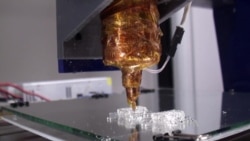Human organ transplants have become fairly common around the world in the past few decades, but doctors and their patients still face the problem of tissue rejection and the need to quickly supply blood to the transplanted organ.
Researchers at various universities are coordinating their efforts to find solutions -- including teams at the University of Pennsylvania and Rice University in Houston that are experimenting with a 3-D printer -- to make blood vessels and other structures for implant.
They are also using these artificial body parts to seek ways of defeating cancerous tumors.
This 3-D printer is using a sugar solution to make molds, which can be used to make silicone veins and arteries.
Implant into rat
The researchers successfully implanted these artificial blood vessels in a rat last year. But lead researcher Jordan Miller said the ultimate goal is to produce structures that can be implanted in humans.
“We are in the field that is trying to find ways to build new tissues and new organ systems for human patients made from their own cells," Miller said.
One idea would be to fill the molds with material commonly found in the body, like collagen, which could be safely implanted with a donor organ to quickly provide a mechanism for blood delivery.
“If we implant a collagen gel, cells from your body can actually come in and replace that collagen gel with their own proteins," said Samantha Paalsen, a graduate student.
Collagen is the material that forms bones, tendons and other connecting tissues in the body.
Along the way, the Rice researchers are looking for ways to use their artificial systems to learn more about one of humankind’s biggest health threats.
“We can use similar models to this, with our blood vessels that we have designed, and then we can study how cancer cells can go from a primary tumor into the blood vessels,” she said.
3-D printer
All of this research is made possible by this specially produced, fast and accurate 3-D printer, which Miller said is a device designed for cutting metal that has been adapted for this experiment.
“We can use the same firm ware that everyone is using for 3-D printing, but we are extruding sugar from it instead of cutting metal," Miller said.
Miller’s team produced this device and shared the design online with the RepRap.org community, through which people around the world create machines that can, to some extent, create their own parts.
“This type of open-source movement has really empowered science. This is what science is supposed to be about; you are supposed to be able to reproduce someone else’s work," he said.
Miller cautions that it could take many years of further research before these 3-D printed devices benefit human patients. But through their collaborative effort, he and his team members hope to see that dream realized.








